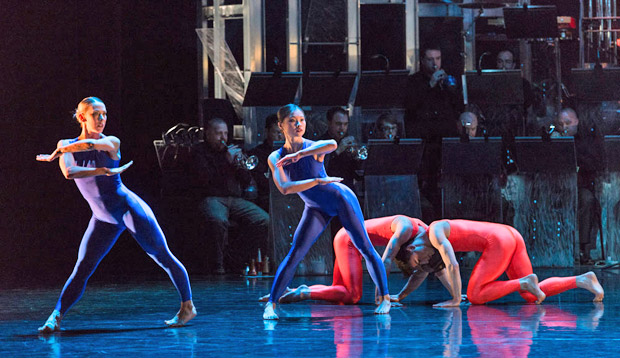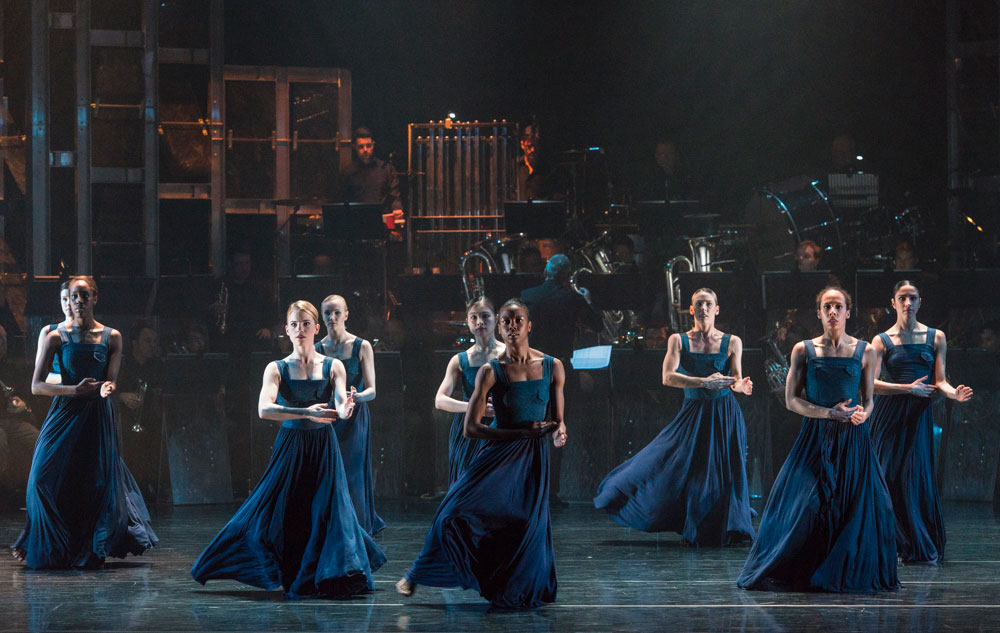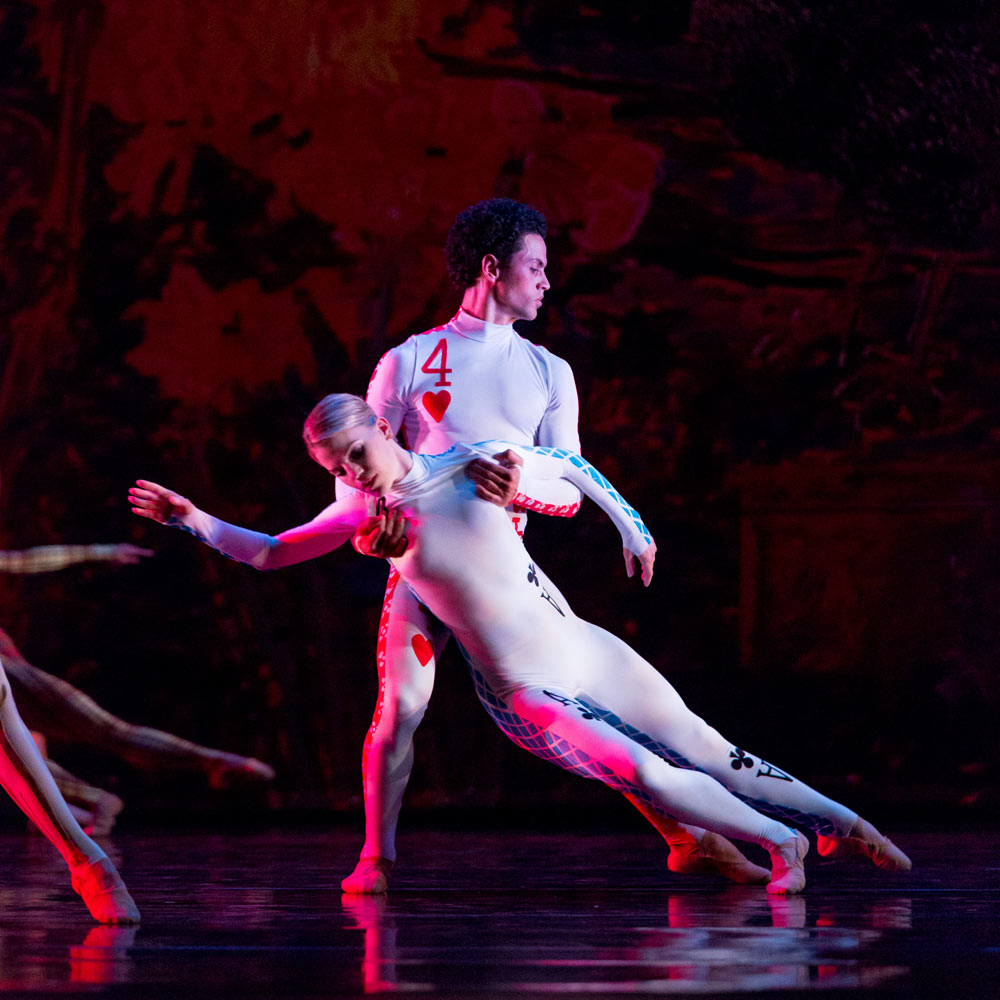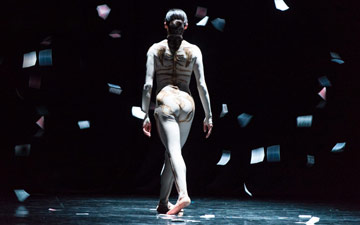
© Foteini Christofilopoulou. (Click image for larger version)
Rambert
Frames, Four Elements, Dark Arteries
London, Sadler’s Wells
12 May 2015
Gallery of Dark Arteries pictures by Foteini Christofilopoulou
Gallery of Frames pictures by Stephen Wright
rambert.org.uk
www.sadlerswells.com
The world premiere of Dark Arteries was greeted with applause the moment 32 members of the Tredegar Town Band were revealed in steep tiers at the rear of the stage, brass instruments gleaming under the lights. Michael Howells had constructed a set around them, with scaffolding towers and perspex shields protecting them from the dancers: the musicians and their conductor, Ian Porterhouse, were the key performers of the work, commemorating the mining communities that lost their livelihood 30 years ago.
Gavin Higgins, Rambert’s first Musical Fellow, comes from a family of brass band players. Dark Arteries is his tribute to the power of music to unite and sustain troubled communities. Though the title refers to a poem about coal mining in Wales by Mervyn Peake, it has echoes of Dark Elegies, Antony Tudor’s 1937 ballet for Rambert about grief-torn families. Mark Baldwin’s choreography acknowledges Tudor’s ballet and the miners’ strike of 1984-1985, without being specific about time or place.

© Foteini Christofilopoulou. (Click image for larger version)
The opening section starts with deep rumbles from the tubas as a line of women enters in long dark dresses – a visual reference to the women in Dark Elegies. They are the backbone of the community, which breaks into trios and duets as the men enter and the music livens, becoming more industrial: gentle tubular chimes are overtaken by clanging percussion.
In the second section, the conflict of the strike is evoked in the aggression of the dancers and the agitated music, rising to a clamorous climax. The perspex sheets in front of the lower tier of musicians resemble police shields, as the dancers hurtle across the stage, shaking their fists in combative rage. Defeated, they collapse on the ground as the lighting changes to suggest a changed environment, a post-industrial society.

© Foteini Christofilopoulou. (Click image for larger version)
Small Lucy Balfour and tall Adam Park introduce the last section in an adagio duet that is taken up by other couples, now dressed in vividly coloured bodysuits. A male couple, Pierre Tappon and Luke Ahment, both in orange, grapple head to head, crawling on their knees. Their resolution into a passionate, forgiving duet is witnessed by a Greek chorus of women in the dark dresses of their first appearance. The elegiac music refers back to the opening section, implying that the community is healing itself into harmony with its past. The sonorous rumbles of the tubas and the two men once again butting head to head make for an unsettling resolution.
Higgins’s music will certainly stand on its own as a concert piece (or brass band competition challenge). Baldwin’s allusive choreography would suffer without the live wall of musicians and instruments to dominate its contrasting sections. Its emotional charge is uncertain, its duets unrevealing; its flickering power comes from the ensembles and the music driving them.

© Stephen Wright. (Click image for larger version)
The other new piece in the triple bill is Alexander Whitley’s Frames, given its premiere in March on tour in Glasgow. It, too, has a percussive industrial score, commissioned from Icelandic composer Daniel Bjarnason. It’s impossible to tell how much is pre-recorded, played live or passed through a synthesiser, as well as amplifiers, to painful effect.
Frames puts Rambert’s dancers to work, uniformly dressed in white shirts and grey trousers, with socks instead of steel-capped boots. The first man to arrive, Dane Hurst, carries a slender metal pole that he uses as a prop to investigate ways of moving around it: a touch of Fred Astaire dancing with a cane or broom handle. When the other eleven enter, their actions are initially more task-like, measuring and constructing shapes with hinged rods.

© Stephen Wright. (Click image for larger version)
At one point, they co-operate to fix the flexible rods into ballet barres, an integral part of dancers’ working lives. But because the ingenious structures they make are swiftly dismantled, their busy activities become meaningless, less interesting than the ‘abstract’ shapes of contemporary dance. Whitley has tried to reanimate the piece by adding lamps to the frames so that they cast shadows on the darkened stage. He sets the dancers moving in canon to fan out their poles, then re-assembles them in duets within the frames.
He has run out of combinations long before the finale, in which the poles are laboriously linked into a lighting rig suspended above the stage. Bjarnason’s score clangs bombastically as the dancers carry on performing without their props, by which time there is nothing more to think about the transience of dance. Enough already.
Lucinda Childs’ Four Elements, commissioned for the company in 1990, is a salutary example of how less is more. She is famous for the repetitive minimalism of her choreography, consisting in this piece of triplet runs, swift turns, and the triangular shapes of leaps and arabesques. Dancers have to be precise, tireless, limbs kept straight, not curved (a reproach to those not on form).

© Benedict Johnson. (Click image for larger version)
Gavin Bryars’s inventive score requires blaring horns, deep bass instruments and versatile percussion, including a water gong. He sets the pace and timbre for each of the elements: heaven knows what Jennifer Bartlett’s four paintings depict, other than the seasons in the countryside, complete with red tank, skull and bones. One of the dancers is costumed as a skeleton: maybe she represents Death from the Tarot card pack, a reminder that death holds all the cards that flutter down from the flies at the end.
Design-wise, it’s a messy piece, with distracting costumes – four men in hideous tartan, two women as suits of playing cards, another as a domino. But the rigorously nuanced choreography is a clear, clean, unpretentious pleasure. Rambert’s repertoire, under Baldwin’s direction, continues to divert and instruct in its combination of classic revivals and bold commissions.

















You must be logged in to post a comment.